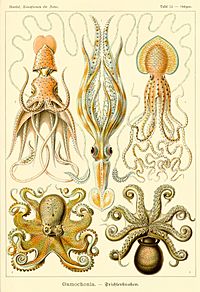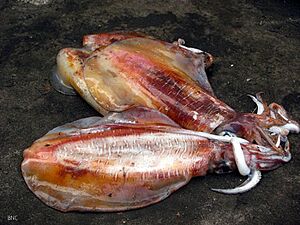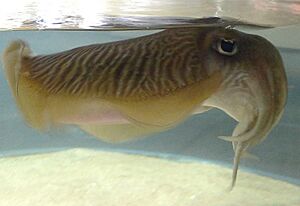Coleoidea facts for kids
Quick facts for kids Coleoids |
|
|---|---|
 |
|
| Various octopus and squid. | |
| Scientific classification | |
| Kingdom: | |
| Phylum: | |
| Class: |
Cephalopoda
|
| Subclass: |
Coleoidea
Bather, 1888
|
| Orders | |
|
|
Coleoids are a special group of cephalopods. This group includes amazing sea creatures like octopuses, squids, and cuttlefish. You might know them as the "soft-bodied" animals of the ocean.
Unlike their relatives, the nautiluses, coleoids do not have a hard outer shell. Instead, they have a small, internal shell or support structure. This inner shell helps them float or gives their body shape. Some coleoids have even lost this internal shell completely! Scientists often group coleoids based on how many arms or tentacles they have.
Contents
What are Coleoids?
Coleoids belong to the Mollusca phylum, which also includes snails and clams. But coleoids are very different! They are known for their intelligence and unique ways of moving. They use jet propulsion to zoom through the water.
Types of Coleoids
There are three main types of coleoids alive today:
Octopuses
Octopuses are famous for having eight arms. These arms are covered in strong suckers. They use their arms to grab prey and explore their surroundings. Octopuses are very smart and can solve puzzles. They can also change their skin color and texture. This helps them blend in with their surroundings. They are masters of camouflage!
Squids

Squids have eight arms and two longer tentacles. They use their tentacles to catch fish and other small sea animals. Squids are often fast swimmers. They have a torpedo-shaped body. Many squids live in the open ocean. Some can even grow to be very large, like the giant squid!
Cuttlefish

Cuttlefish are similar to squids but have a wider, flatter body. They also have eight arms and two tentacles. Cuttlefish are known for their amazing ability to change color. They use this skill to hide from predators or to communicate with other cuttlefish. They have a unique internal shell called a "cuttlebone." This cuttlebone is filled with gas and helps them control their buoyancy.
Internal Shells and Support
Most coleoids have some kind of internal support. This is different from the hard outer shell of a snail or clam.
The Cuttlebone
The cuttlebone is found in cuttlefish. It's a porous, chalky structure. It helps the cuttlefish float at different depths in the water. The cuttlefish can fill or empty tiny chambers in the cuttlebone with gas or water. This acts like a natural buoyancy control device.
The Gladius
Squids have a thin, feather-shaped internal shell called a gladius. It's made of a tough, flexible material called chitin. The gladius helps support the squid's body. It also gives muscles something to attach to. It's much lighter than a cuttlebone.
No Shell at All
Many octopuses have no internal shell at all. This makes them very flexible. They can squeeze into tiny spaces. This is why octopuses are so good at hiding in cracks and crevices. Their soft bodies allow them to be very agile.
How Coleoids Live
Coleoids are predators. They hunt for fish, crabs, and other small sea creatures. They use their strong arms and suckers to catch their prey. Many coleoids also have a sharp beak, like a parrot's beak. They use this to bite and tear their food.
Amazing Camouflage
One of the most incredible things about coleoids is their ability to change color and texture. They have special cells in their skin called chromatophores. These cells allow them to instantly change their appearance. They can blend in with rocks, sand, or even seaweed. This helps them hide from predators and sneak up on prey.
Movement and Defense
Coleoids move by using jet propulsion. They suck water into a special cavity and then squirt it out through a funnel. This pushes them quickly through the water. If they feel threatened, many coleoids can also release a cloud of dark ink. This ink confuses predators and gives the coleoid time to escape.
History of Coleoids
Coleoids have been around for a very long time. Their ancestors lived millions of years ago. The oldest known coleoids appeared during the Carboniferous period. This was about 360 to 300 million years ago. Over time, they evolved to lose their heavy outer shells. This allowed them to become faster and more agile hunters.
See also
In Spanish: Coleoideos para niños

